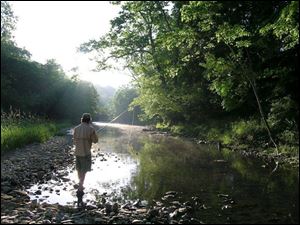
Smallmouth bass, small stream a big time
6/22/2007BETHEL, Ohio - Wading a small stream in summer for smallmouth bass is about getting back to the basics.
As in going with the flow, demanding no more of the morning than lazily rising mists, a warming sun, chuckling current, and whatever fish come along. It is about relaxing and enjoying, not going the fastest or getting the biggest and mostest.
Gear and tackle are purposely minimal.
Waders are nothing more than a pair of water socks with soles hard enough to fight off the rocks and a pair of quick-dry shorts with lots of pockets.

A true fan of fi shing in the small streams, Ohioan Chip Hart of Batavia casts into the rising mists of a summer morning on the East Fork of the Little Miami River hoping for a smallmouth bass.
The pockets are your tackle box. You jam an extra rod and reel, butt-end first, into a back pocket. It is rigged with a small spinnerbait or a small buzz bait in case you run into aggressive or active surface-feeding fish.
Side cargo pockets of the shorts hold a couple of packets of small soft-plastic tubes in green/pumpkin and watermelon/copper, plus a pack each of 1/0 worm hooks and 1/16-ounce bullet weights - all for making up weedless Texas-rigged tubes for your primary rod, likely a light or ultralight spinning outfit. That's about it.
Then all you have to do, as they say, is add water.
Chip Hart, a buddy from Batavia down southwest in Clermont County, had the East Fork of the Little Miami River in mind, near where its tailwaters flow from the dam of East Fork Lake.
Built by and known to the U.S. Army Corps of Engineers as William H. Harsha Lake, East Fork is a flood-control reservoir that covers 2,160 acres at summer pool. Its outflow gives the stream below a fairly reliable run of water. That is critical right now.
Hart had considered several other popular southwest possibilities, such as the famous Ohio Brush Creek, but a drought has ruined the flows and fishing in them for now. So the East Fork it was to be. "It's the only one with running water," he said.
The man is a fan of the little stream, and last fall caught a four-pound smallmouth from it. Not that we were making those kind of demands on this summer sojourn.
Because it was about fishing, we got up early and slipped down to the stream by 6:30 a.m.
Those first few getting-your-bearings steps into the stream were as much eye-openers as the earlier pot of coffee. Coolish, to say the least. In fact, later, after a couple of hours of wading it got chilly in the shade - right down to some shivering, followed by a prompt seeking-out of warmer, sunlit stretches of stream.
Chip picked up a hellgrammite, a gnarly-looking, two to four-inch larva of a dobsonfly. He scooped it as it swam by, adding "Karl loved these for bait."
He was talking about the late Karl Maslowski, a world-renowned Cincinnati area nature photographer, naturalist, hunter, and angler who practically was an uncle to Hart. Maslowski died last summer at 93, but Chip remembers him well and often.
Along the way, rock-picking and making our way slowly downstream, we cast to every pool and pocket and likely hiding hole. A small stream, crowded to the banks with brush and overhanging trees, makes an accurate caster out of you. This kind of fishing - where you are finessing a small tube into little corners and just swimming and twitching it slowly over rocks - also forces you to slow down and be patient. Do that and you find yourself focusing on the moment, and relaxing. Imagine.
A small queen snake swam along the rocky bottom and Hart picked it up briefly, examined it, returned it. One of the morning's natural curiosities.
Three drake mallards fed and paddled slowly just ahead of us most of the morning, all but unconcerned over our slow-paced, quiet presence. Bank swallows dived and soared and circled, nipping insects over the stream and at times zooming so close you thought they would hit you.
A nice blue indigo bunting graced the greenery, and a kingfisher chattered up the small valley occasionally, perhaps when it was tired of the peace and quiet.
The extra rod in the back pocket occasionally got to be a pain, but it was a small price to pay.
"I always carry two," explained Hart. "Just in case. And you don't have to spend half your time tying lures on." Good enough.
Oh, yeah. The fish. We didn't catch plenty. We didn't catch huge. But the handful of smallmouth - the bite was finicky this morning - were fun and feisty. And they were joined by another handful of scrappy rock bass. Enough to have fished.
"It's the whole package," said Hart as we slogged back uphill in squishy, sand and gravel-filled water socks.
"It's the experience, whether you get something or not."
Amen to that.
Contact Steve Pollick at:
spollick@theblade.com
or 419-724-6068.